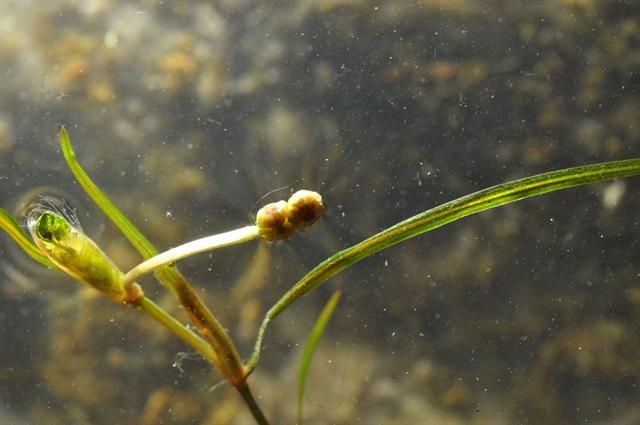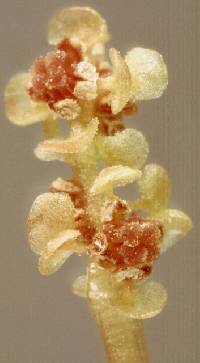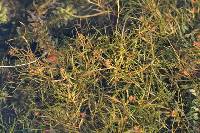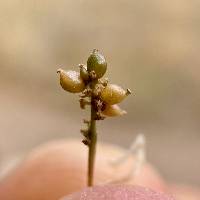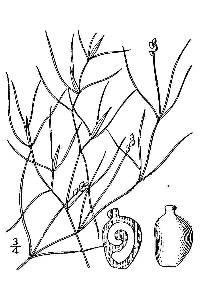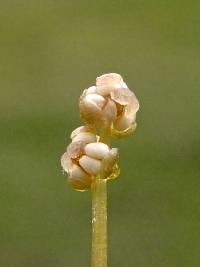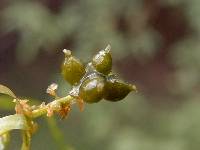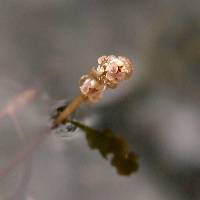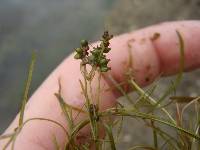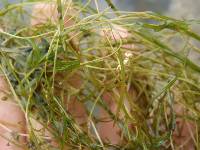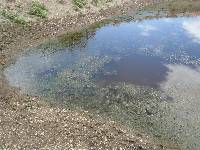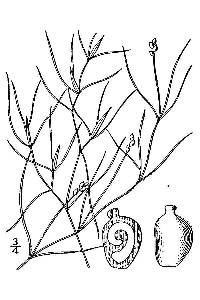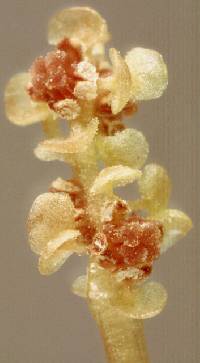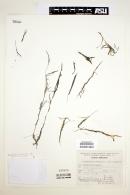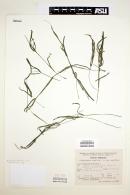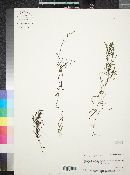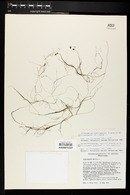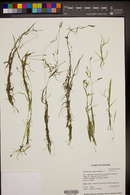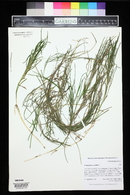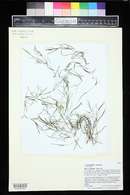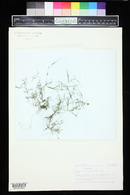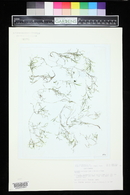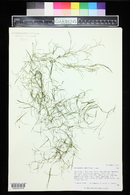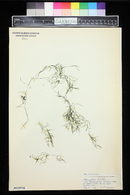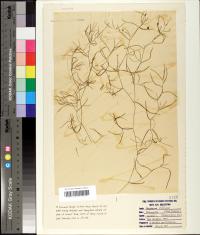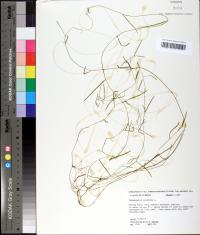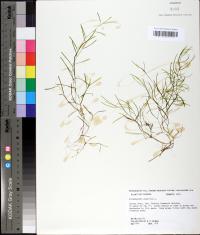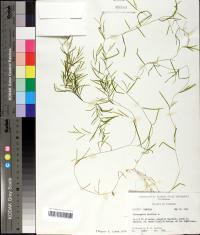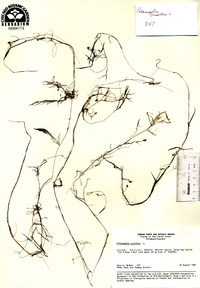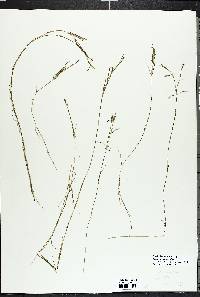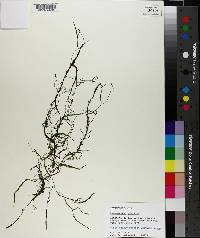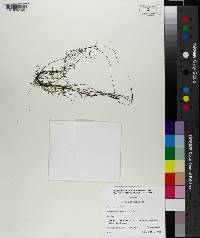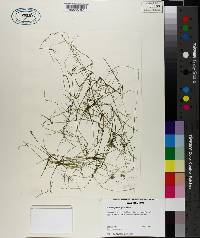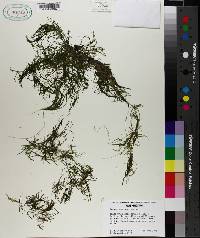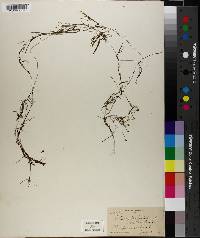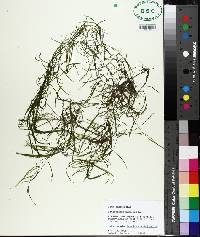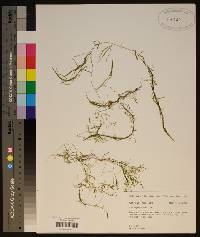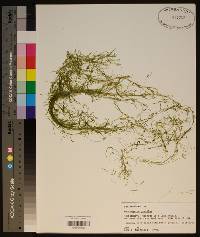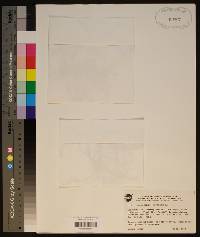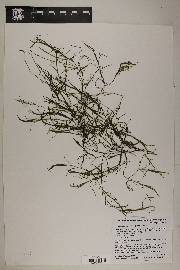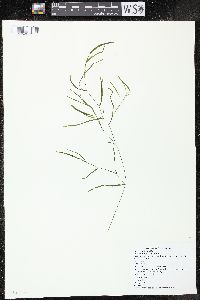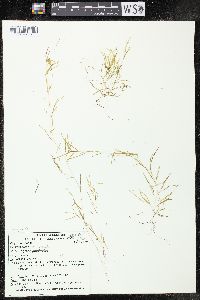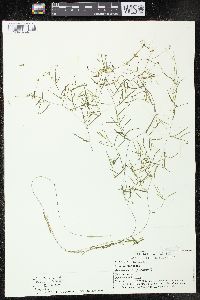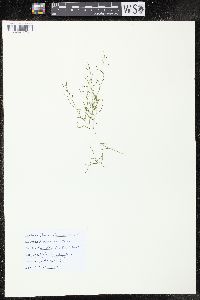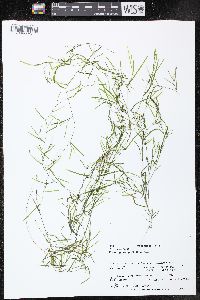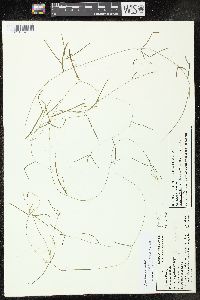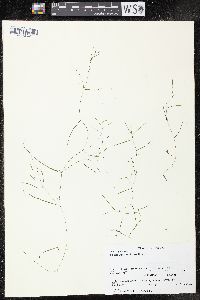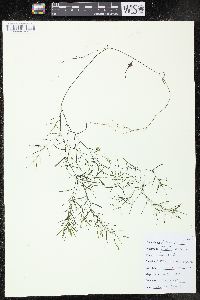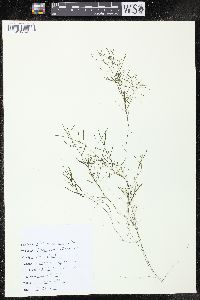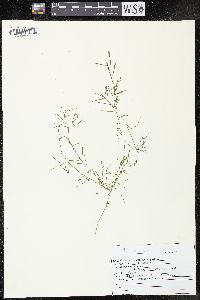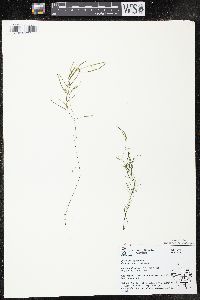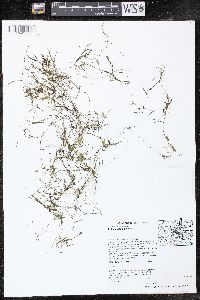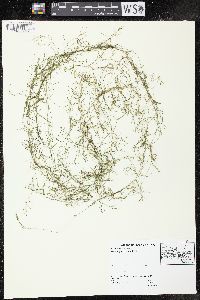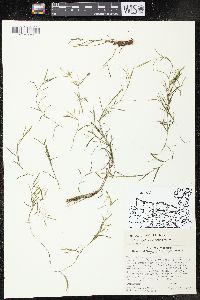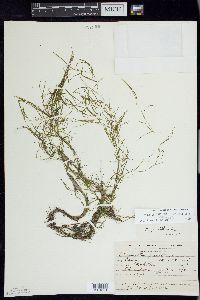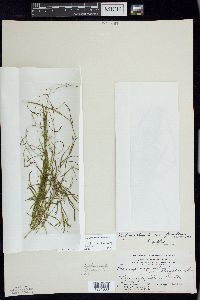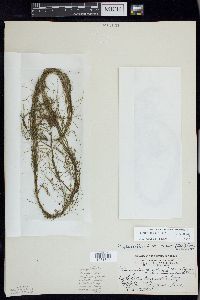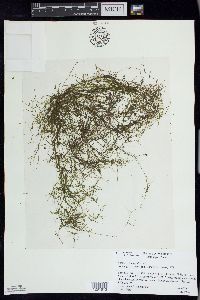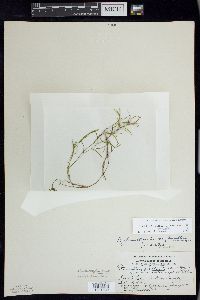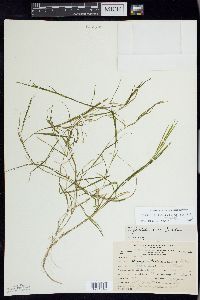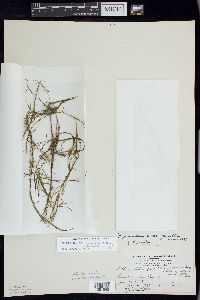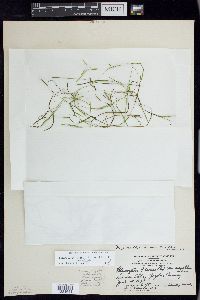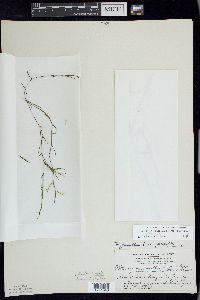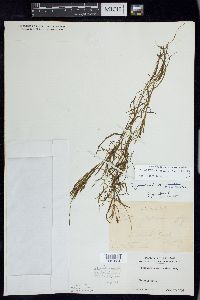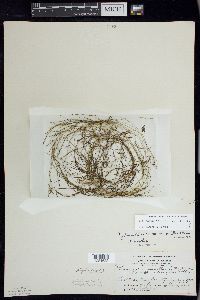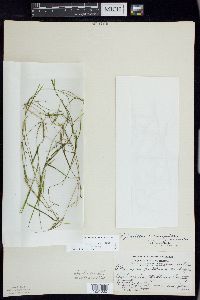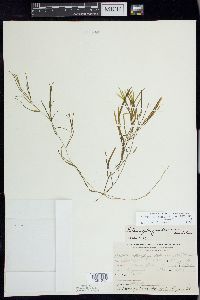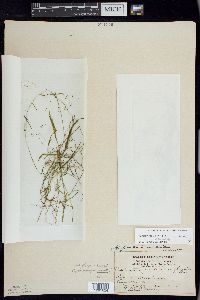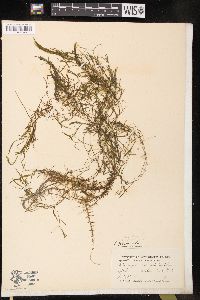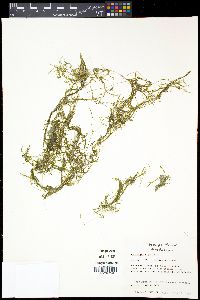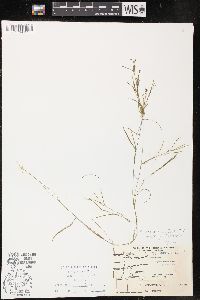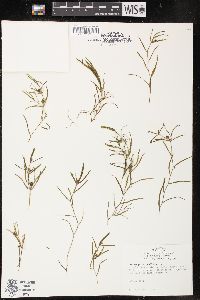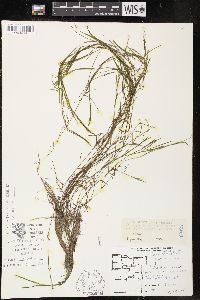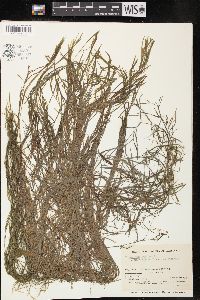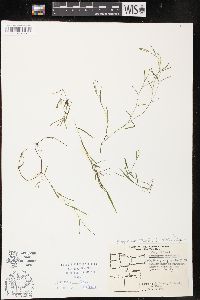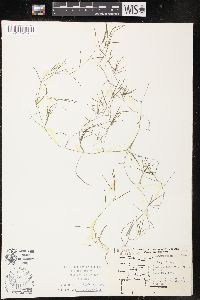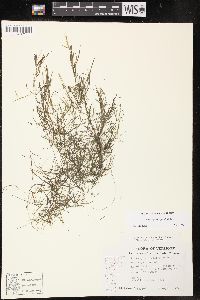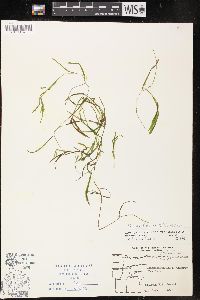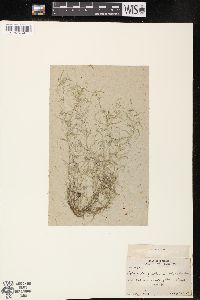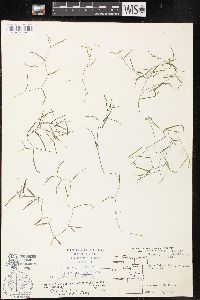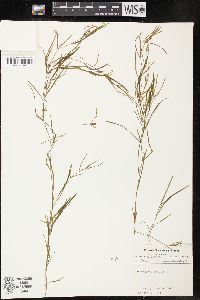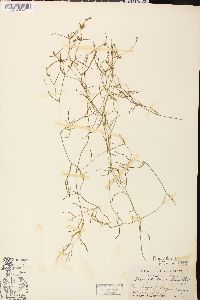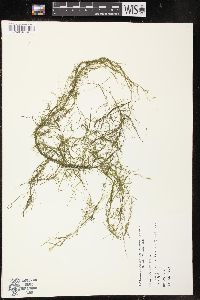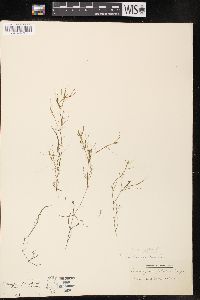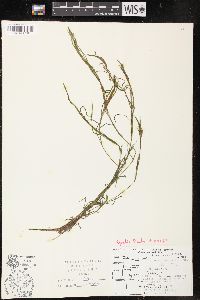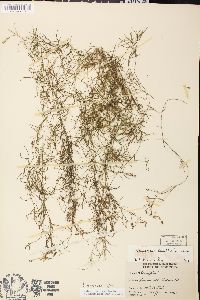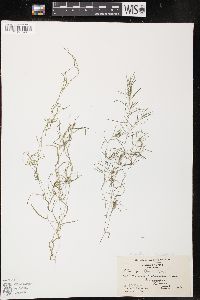Potamogeton pusillus
|
|
|
|
Family: Potamogetonaceae
Small Pondweed, more...baby pondweed
[Potamogeton antaicus Hagstr., morePotamogeton pusillus var. africanus A. Benn., Potamogeton pusillus var. austrinus Hagstr., Potamogeton pusillus var. capitatus A.Benn., Potamogeton pusillus var. elongatus A.Benn., Potamogeton pusillus var. typicus , Spirillus pusillus (L.) Nieuwl.] |
Rhizomes absent. Cauline stems terete to slightly compressed, without spots, 18--150 cm; glands present on at least some nodes, green, gold, brown, or rarely white, to 0.5 mm diam. Turions common, soft, lateral or terminal, 0.9--3.2 cm ´ 0.3--1.8 mm, soft; leaves ± 2-ranked; outer leaves 1--3 per side, base not corrugate, apex subulate to obtuse; inner leaves rolled into hardened fusiform structure. Leaves submersed, ± spirally arranged, sessile, delicate to coarse; stipules persistent, inconspicuous, connate or convolute, free from base of blade, brown to green or white, not ligulate, 0.31--0.92 cm, rarely appearing fibrous, not shredding at tip, apex obtuse; blade pale green to olive-green, rarely somewhat reddish, linear, not arcuate, 0.9--6.5 cm ´ 0.2--2.5 mm, base slightly tapering, without basal lobes, not clasping, margins entire, not crispate, apex not hoodlike, subulate to obtuse, lacunae absent or present, in 0--5 rows each side of midrib; veins 1--3(--5). Inflorescences unbranched, submersed or emersed; peduncles not dimorphic, axillary or terminal, erect, rarely recurved, filiform to slightly clavate, 0.5--6.2(--6.6) cm; spikes not dimorphic, capitate to cylindric, 1.5--10.1 mm. Fruits sessile, green to brown, ovoid to obovoid, turgid to concave, not abaxially or laterally keeled, 1.5--2.2 ´ 1.2--1.6 mm; beak erect, 0.1--0.6; sides without basal tubercles; embryo with less than 1 full spiral. Three hybrids, Potamogeton perfoliatus ´ P. pusillus (= P. ´ mysticus Morong), P. friesii ´ P. pusillus (= P. ´ pusilliformis Fisher [P. ´ intermedius Fischer]), and P. obtusifolius ´ P. pusillus (= P. ´ saxonicus Hagström), have been described.
Perennial submersed aquatic herb 18 cm - 1.5 m tall Stem: very slender, much-branched above, jointed, with or without nodal glands. Glands green to yellow to brown (rarely white), to 0.5 mm wide. Leaves: submersed, more or less arranged spirally, stalkless, translucent, pale green to olive green, sometimes slightly reddish, 0.9 - 6.5 cm long, 0.2 - 3 mm wide, narrowly linear with a slightly tapering base and awl-shaped to blunt tip, typically one- to three-veined. Stipules axillary, free from leaf blade, brown to green or white, to 1 cm long, rolled up or with fused margins. Inflorescence: an upright, head-like to cylindrical spike with one to four whorls of flowers, submersed or emersed, unbranched, 1.5 - 10 mm long, on a terminal or axillary stalk. Stalk thread-like to cylindrical to slightly club-shaped, 0.5 - 6 cm long. Flowers: greenish, tiny. Stamens four. Anthers two-chambered, with four edge-to-edge sepal-like outgrowths. Fruit: an achene, stalkless, green to brown, 1.5 - 2 mm long, 1 - 1.5 mm wide, egg-shaped to reverse egg-shaped, plump to concave, not keeled, with an upright, 0.1 - 0.6 mm long beak. Similar species: Refer to the subspecies links below. Flowering: July to mid-September Habitat and ecology: Frequent in lakes, ponds, streams, and ditches, especially in calcareous waters. Occurence in the Chicago region: native Notes: Plants in the genus Potamogeton are very important to wildlife, offering habitat and food for many aquatic animals. Etymology: Potamogeton comes from the Greek words potamos, meaning river, and geiton, meaning neighbor, referring to the habitat of these plants. Pusillus means insignificant, weak, or very small. Author: The Morton Arboretum FNA 2000, Cronquist et al. 1977 Duration: Perennial Nativity: Native Lifeform: Forb/Herb General: Wholly submersed plant with small slender stem that is terete to slightly compressed, 18-150 cm in length, much branched above, emerging from a creeping rhizome. Leaves: All submersed, the blade narrowly linear, more or less two-ranked, with 1-3 outer leaves per side, tapering and sessile at base, attached directly to the stem with two small glands immediately below, blade pale green to olive green to 6.5 cm long, under 2.5 mm wide. Flowers: Unbranched peduncles, axillary or terminal, 1-5 cm long, spikes somewhat congested, 5-15 mm long with 1-3 whorls of 2-3 flowers, the flowers small with greenish tepals 1-2 mm long, the style short. Fruits: Sessile, obliquely obovoid 2-2.5 mm long, 1-2 mm wide, not keeled. Ecology: Found in shallow still water and slow moving streams up to 11,000 ft (3353 m), flowers July-August. Distribution: Widespread aquatic ranging across Eurasia and North America, from southern Canada to northern Mexico. Notes: FNA designates both subsp. pusillus and subsp. tenuissimus as being present in Arizona. Collections are needed to better understand the distribution of this species and genus in general. Ethnobotany: Unknown Etymology: Potamogeton comes from Greek potamos, a river and geiton, for neighbor, while pusillus means weak, small, or insignificant. Synonyms: Many, see Tropicos Editor: SBuckley, 2011 Stems very slender, to 1.5 m, with numerous branches distally, with or without nodal glands; rhizome scarcely developed; lvs all submersed, narrowly linear, 1-7 cm נ0.2-2.5 mm, 1- or 3(5)-veined, with 0-5 rows of lacunar cells on each side of the midvein; stipular sheaths axillary, free, to 1 cm, delicate, the margins connate or merely overlapping; winter-buds commonly produced,
1-3 cm, the inner lvs rolled into a hard, fusiform structure; peduncles filiform to slightly clavate, axillary or
terminal, mostly erect, 0.5-6 cm; spikes capitate to cylindric, 2-10 mm, with 1-4 whorls of fls; body of the fr
ovoid to obovoid, usually plump, not keeled, 1.5-2.2 mm, the beak 0.1-0.6 mm; 2n=26. Common and
widespread in both acid and alkaline waters from Nf. to Alas., s. to Fla. and Mex. Highly variable. (P. berchtoldii; P. panormitanus; P. tenuissimus) The most narrow-lvd phase, with subulate, 1-nerved lvs 0.2-0.6 mm wide, considered to be restricted to N. Engl. and s. Que., has been called var. gemmiparus Robbins. (P. gemmiparus) Gleason, Henry A. & Cronquist, Arthur J. 1991. Manual of vascular plants of northeastern United States and adjacent Canada. lxxv + 910 pp. ©The New York Botanical Garden. All rights reserved. Used by permission. |
|
|
|

